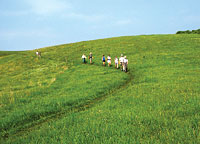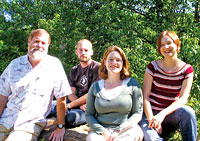My husband I maintain a 4.9-mile piece of the Appalachian Trail from Rice Gap to Devils Fork Gap along the Tennessee border. We clip brush that’s obstructing the trail, pick up garbage, weed-whack the sides of the trail and refresh the white blazes. When we run into something we can’t handle, we go up a chain of command that ends at the Appalachian Trail Conservancy’s regional office in Asheville.

Trails do not maintain themselves. People maintain trails, and when the trail in question happens to be 2,175 miles long, it takes a lot of people and a lot of organization to get it done. Volunteers are the AT’s life blood, and much of their work is coordinated through the conservancy, which maintains five regional offices. Headquartered in Harpers Ferry, W.Va., the conservancy is responsible for managing, maintaining and protecting the AT in cooperation with local clubs and land managers such as the U.S. Forest Service. Last year in the Deep South—as the Georgia, North Carolina and Tennessee sections of the trail are known—1,500 volunteers racked up 59,000 hours maintaining the 463 miles from Georgia to Damascus, Va.
A career of caring for the AT

Morgan Sommerville, the conservancy’s southern regional director, is a big man with a full, ruddy beard. His connection with the AT began with an unpleasant incident.
“In 1977, I was ready to take a cross-country bicycle trip but someone stole my bike, so I did the AT instead,” he recalls. Arriving in Asheville in 1983, he worked by himself for a time in the conservancy’s office; today, there are four full-time staffers. In 2003, Blue Ridge Outdoors named Sommerville its Outdoor Person of the Year in recognition of his long-time advocacy for the trail.
What’s on your plate?
Managing North Carolina’s AT license-plate program might not sound like an exciting job, but Leanna Joyner’s eyes light up when she talks about it. The program, she says, is both “a long-term funding source for the AT” and “key to its self-sufficiency.”
Recently, funds from the program enabled the Carolina Mountain Club to buy trail-maintenance tools and helped refurbish chain saws for the Tennessee Eastman Hiking and Canoe Club. In the North Carolina portion of the Roan Highlands, funds from the plate program were used to renovate the Overmountain Shelter near Carvers Gap.
Joyner through-hiked the trail in 2003. “I had no responsibilities at the time,” she recalls. “It was a good time to do this, to take a break and reflect. I went out to hike, but it did change my perspective—small things seem more important.”
Are you strong enough to SWEAT?
Andrew Downs, the newest member of the conservancy’s office crew, works with the Smokies Wilderness Elite AT Crew. Maintaining the AT in the Smokies often involves backpacking, because many portions are just too remote to service via day hikes. Enter the SWEAT Crew, which focuses on basic maintenance such as cutting back vegetation, removing downed trees and clearing water bars. The mobile unit carries all the necessary food, tools and camping gear into the heart of the park. Crew members are indeed elite—no beginner backpackers need apply.
Downs says he was determined to earn the position. After finishing college in 2002, he through-hiked the AT. “It was supposed to be a buddy trip, but my buddy left the trail before finishing. I was looking for a challenge and to teach myself a lot of things. The hike opened my eyes to what it took to maintain the trail. I figured there had to be jobs here someplace.” Downs has since earned an advanced degree in natural-resources management and outdoor recreation.
Learning along the trail
Julie Judkins didn’t hike the AT after college. Instead she joined the Peace Corps and was sent to Armenia, where she hiked across the country raising environmental awareness. When she came back, she worked for Outward Bound. Now the conservancy’s resource-program manager, she monitors open balds such as Max Patch and the Roan Highlands, which are maintained through mowing or grazing. She also helps protect plants along the trail and controls non-native, invasive species such as kudzu, Japanese honeysuckle and Oriental bittersweet.
Judkins brought an outreach program, A Trail to Every Classroom, to Hot Springs, where the AT runs right down the main street. A fourth-grade classroom adopted a small piece of the trail and cut back the invasives there. The children also read and responded to through-hikers’ journals.
Keeping tabs on Hollywood
Then there are the more glamorous assignments. Bill Bryson’s A Walk in the Woods (Broadway, 1999), the book that brought the AT to every corner of the world, is going to be made into a movie, and Sommerville is the primary liaison with the production company. The producers have scouted potential locations up and down the trail, but Sommerville expects that much of the film will be shot in Western North Carolina, probably on the Mountains-to-Sea Trail because of the easy access.
“If the movie takes place, we’re concerned about the increased use on the AT,” he notes. After the book came out, the number of hikers starting the AT jumped by 10 to 15 percent.
It’s all about the hiking
How important is it for conservancy staffers to have hiked the entire trail? Everyone in the office agreed that it’s not essential, but it helps to have done at least some of it and to understand how the trail-maintenance clubs work.
The AT isn’t just for hard-core endurance types; it’s there for day-hikers and section-hikers as well, and its hold on the American imagination is considerable. Judkins remembers receiving a letter from a woman in her 80s who wanted to get on the AT just to be able to say she’d been there. Judkins found her an appropriate access point and in turn was rewarded with photos of the woman on the trail—an “AT moment” if there ever was one.
[Hike leader and outdoors writer Danny Bernstein is the author of Hiking the Carolina Mountains (Milestone Press, 2007). She can be reached at danny@hikertohiker.com]



Before you comment
The comments section is here to provide a platform for civil dialogue on the issues we face together as a local community. Xpress is committed to offering this platform for all voices, but when the tone of the discussion gets nasty or strays off topic, we believe many people choose not to participate. Xpress editors are determined to moderate comments to ensure a constructive interchange is maintained. All comments judged not to be in keeping with the spirit of civil discourse will be removed and repeat violators will be banned. See here for our terms of service. Thank you for being part of this effort to promote respectful discussion.